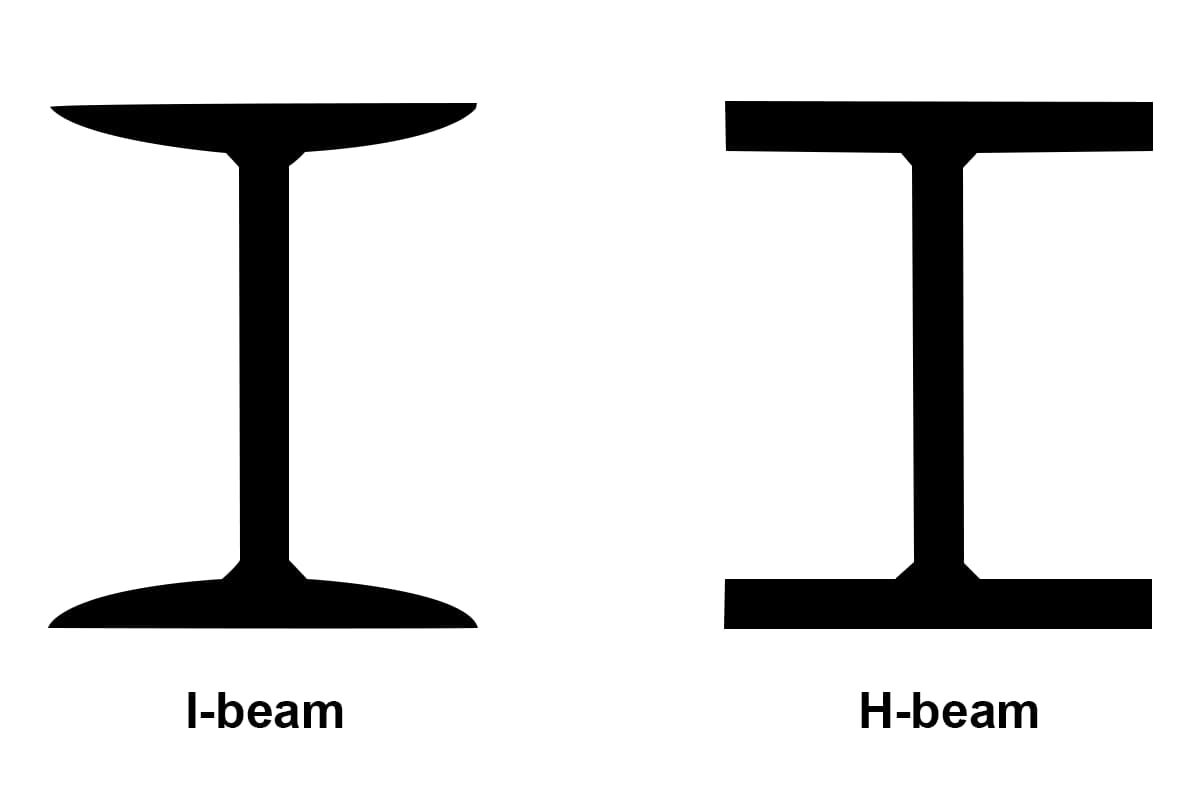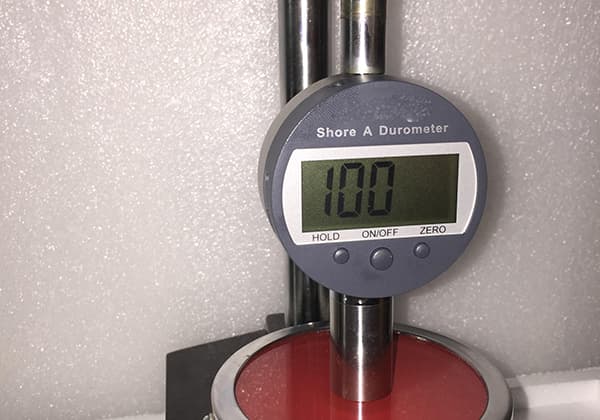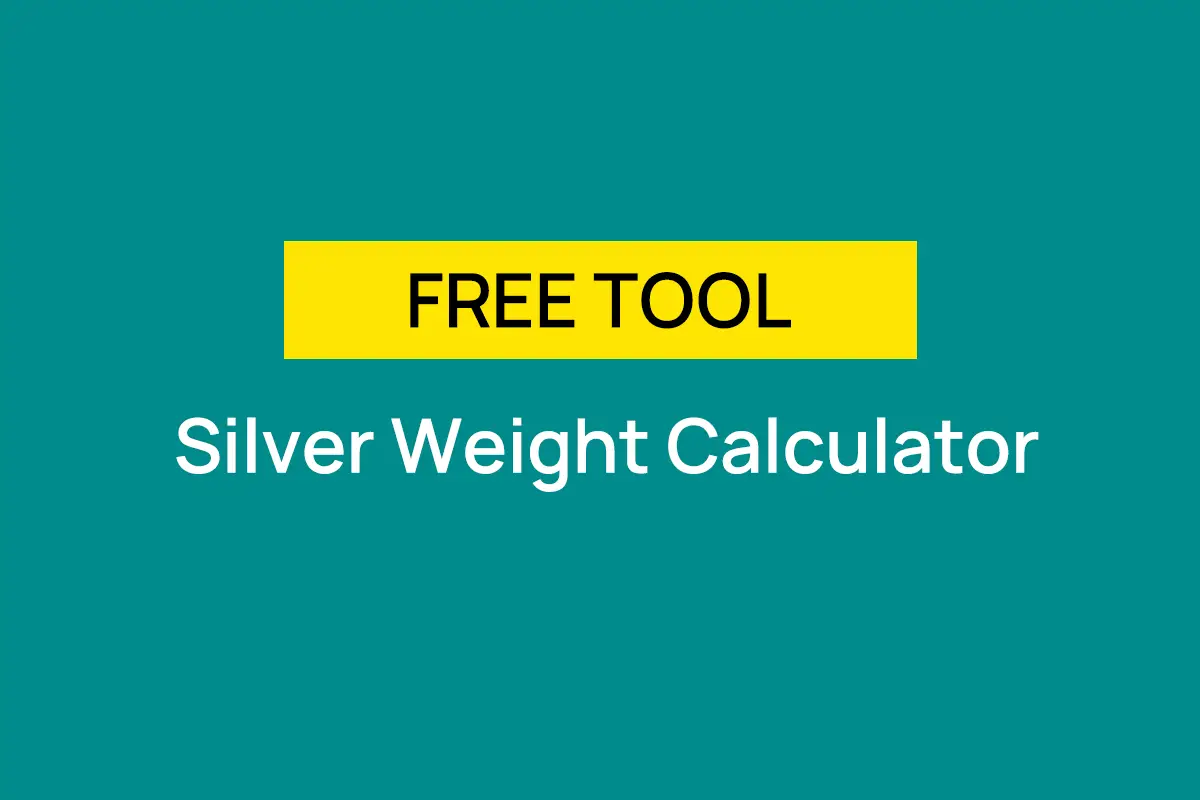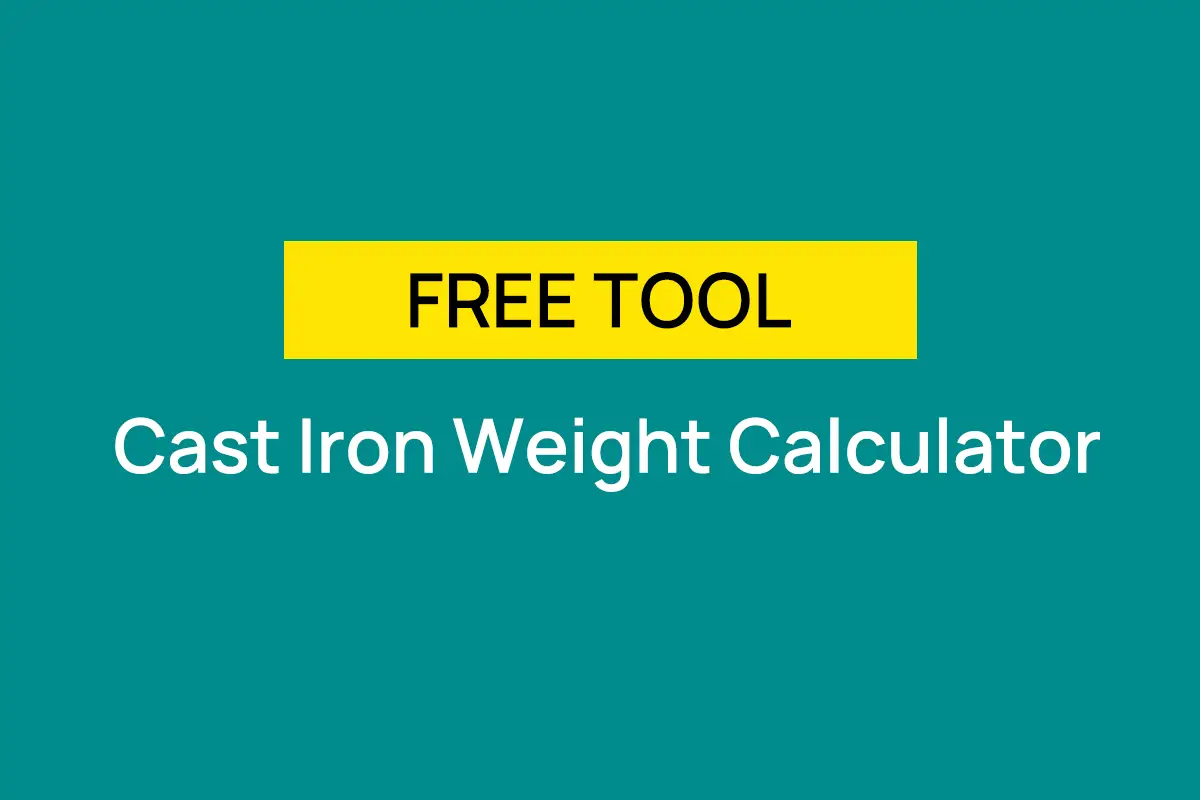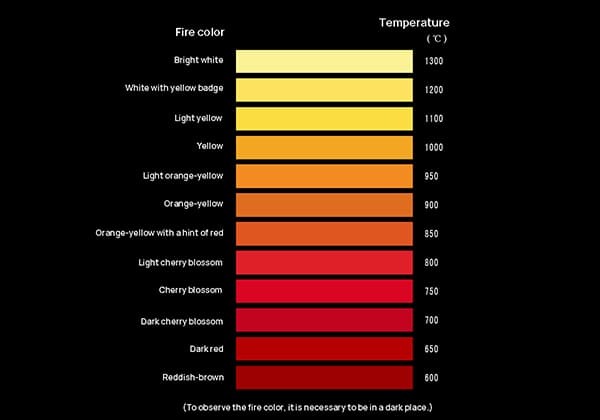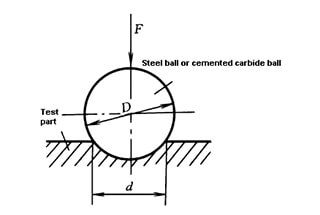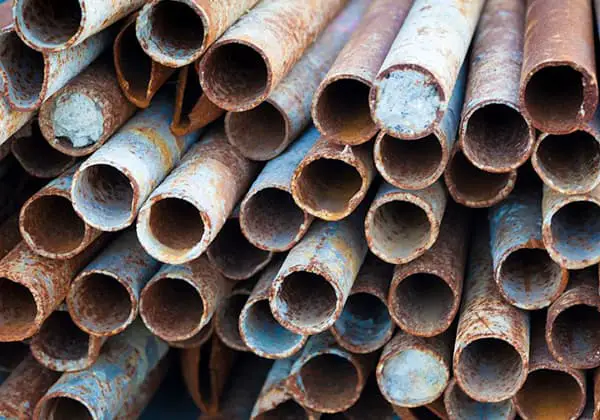
Have you ever wondered what makes modern construction so efficient and durable? This article explores the fascinating world of C-section and Z-section steel purlins, essential building materials that revolutionize construction. Learn how their unique properties and applications can enhance your next project!
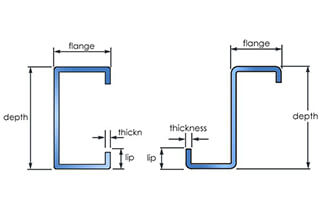
As far as the construction site of relevant construction projects is concerned, at present, what everyone should know is about the use of building materials in the current construction market.
There is no doubt that the two most widely used building materials are actually Z-section steel purlin and C-section steel purlin.
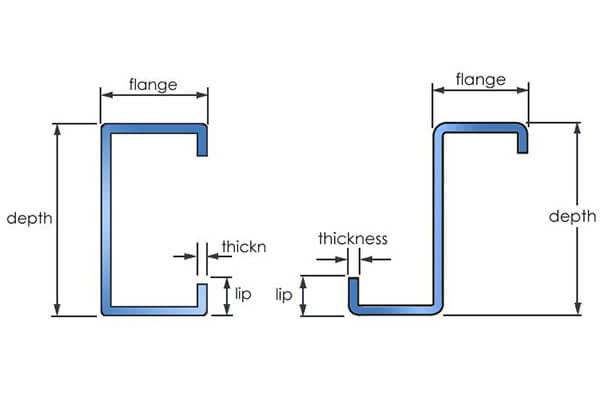
Two types of building materials, Z-section steel and C-section steel, have been developed and put into use in recent years, and Z-section steel and C-section steel have been widely used in the construction industry shortly after they were introduced because of their low carbon and durability.
In the field of the construction industry now involved, there is a very large amount of data on the use of steel in the specific construction process.
In addition, because the current Z-section steel purlin and C-section steel purlin have greatly replaced the status of some more traditional building materials in a certain sense, in fact, this has created a large number of Z-section steel and C-section steel to a certain extent.
| Aspect | C-Section Steel Purlin | Z-Section Steel Purlin |
|---|---|---|
| Included Angle | 90 degrees | 60-75 degrees |
| Mechanical Properties | Different strong and weak axis properties | More balanced mechanical properties |
| Connection to Steel Frame | Usually screw connection; considered as simple support | Often preferred due to better stress distribution |
| Preferred Usage Based on Roof Slope | Preferred for wall purlins and low-slope roofs | Preferred for roofs with large slope |
| Section Modulus on Roof Slope | Slightly lower compared to Z-purlin | Increases symmetrically for larger slopes |
| Choice for Walls | Comparable to Z-purlin | Comparable to C-purlin |
| Continuous Structural Members | Less suitable for overlapping | More suitable due to ease of overlapping |
| Overall Usage | Widely used in various applications | Preferred in specific situations for its advantages |
In order to understand the essential difference between C-section steel purlin and Z-section steel purlin, we need to have a corresponding understanding of C/Z section steel purlin
Next, I will tell you about C-section steel purlin and Z-section steel purlin respectively, and then analyze their essential differences according to the understanding of their use.
The angle between C-shaped steel purlin and Z-shaped steel purlin is different.
The included angle of C-shaped steel purlin is 90 degrees, and the included angle of Z-shaped steel purlin is less than 90 degrees, about 60-75 degrees.
Therefore, the included angle of purlin must be considered in the selection and combined with the corresponding stress knowledge.
Compared with Z purlin, the mechanical properties of the strong and weak axes of C purlin are very different
The connection between C-section steel and steel frame usually adopts screw connection, which must be considered as simple support in the calculation, so the latter is more reasonable in stress, calculation results and structure.
Therefore, in addition to other special processing needs such as door and window openings, Z-shaped steel section shall be preferred, and C-shaped steel shall be preferred for wall purlins and house purlins with small slope;
The roof purlin with large slope shall be Z-shaped.
What kind of purlin should be used in what environment? This is helpful for us to choose building materials.
1. When the roof slope is small, the section modulus of Z-shaped steel purlin is slightly higher than that of C-shaped steel purlin, but the difference is not significant;
When the roof slope increases, the modulus utilization of the Z-shaped steel purlin section increases symmetrically in the vertical direction.
Therefore, Z-shaped steel purlin is suitable for roofs with large slope.
2. For the wall, the choice of Z type and C type is not much different.
3. If purlins want to be continuous structural members, try to use Z-shaped steel purlins because they are easy to overlap.
What kind of environment and what kind of building materials are used in different environments?
The building materials they use play different roles, but C-purlin is still widely used in today’s life.
The above is an essential difference between C/Z steel purlins for everyone to understand.
C-section steel is automatically processed and formed by C-section steel forming machine.
The machine can automatically complete the forming process according to the given size.
C-section steel is processed by hot coil cold bending, with thin wall, lightweight, excellent section performance and high strength.
Compared with traditional channel steel, the same strength can save 30% of materials.
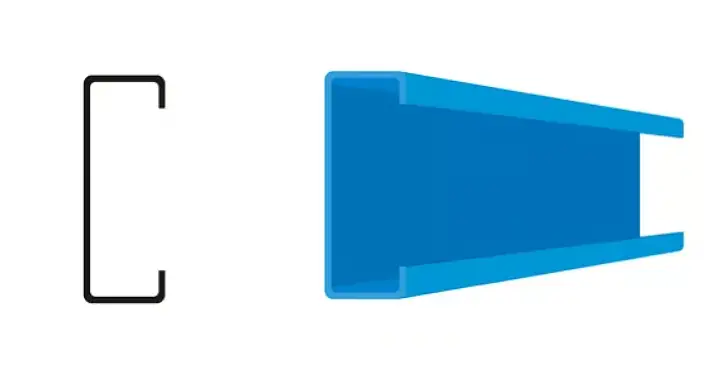
C-section steel is widely used in purlins and wall beams of steel structure buildings, and can also be combined into lightweight roof truss, bracket and other building components.
In addition, it can also be used for columns, beams and arms in mechanical and light industrial manufacturing.
Discharging ① – leveling ② – forming ③ – setting ④ – straightening ⑤ – length measurement ⑥ – punching the round hole of tie bar ⑦ – punching the elliptical connecting hole ⑧ – forming and cutting ⑨
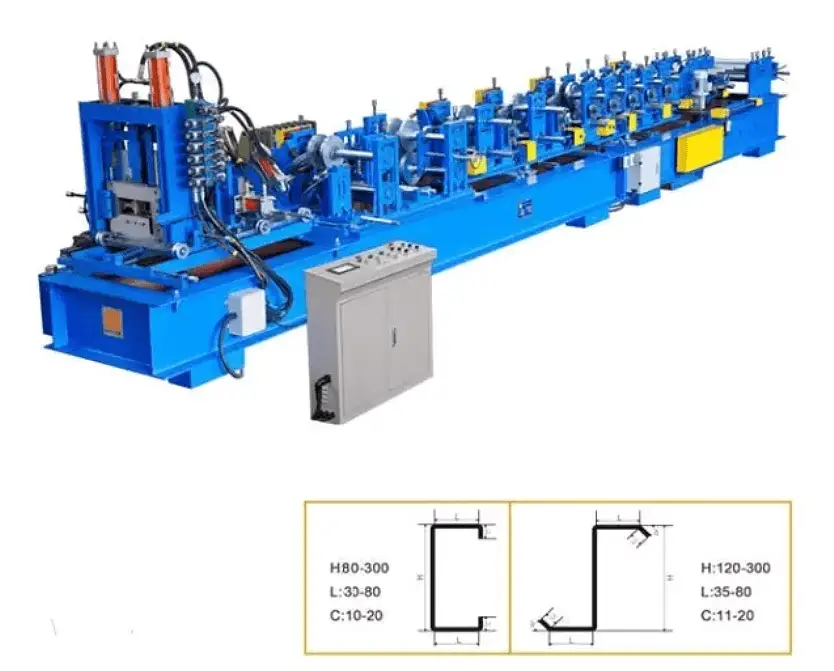
C-shaped steel purlins are divided into five specifications: 80, 100, 120, 140 and 160 according to different heights.
The length can be determined according to the engineering design, but considering the conditions such as transportation and installation, the total length is generally no more than 12m.
Meaning of numbers in each line (take C80×40×20×2.5 as an example):
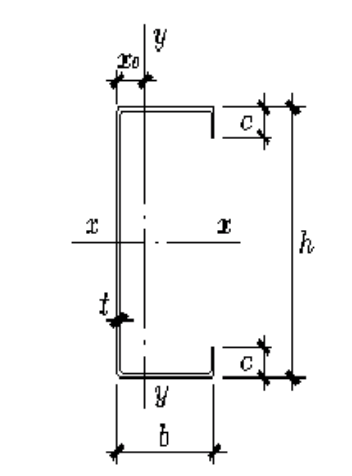
| Model | Sizes (mm) | Cross-sectional area (cm²) | Weight (kg/m) | |||
|---|---|---|---|---|---|---|
| h | b | c | t | |||
| C80 | 80 | 40 | 20 | 2.25 | 4.29 | 3.37 |
| C80 | 80 | 40 | 20 | 2.50 | 4.75 | 3.72 |
| C80 | 80 | 40 | 20 | 2.75 | 5.19 | 4.08 |
| C80 | 80 | 40 | 20 | 3.00 | 5.64 | 4.42 |
| C80 | 80 | 50 | 20 | 2.25 | 4.74 | 3.72 |
| C80 | 80 | 50 | 20 | 2.50 | 5.25 | 4.12 |
| C80 | 80 | 50 | 20 | 2.75 | 5.74 | 4.51 |
| C80 | 80 | 50 | 20 | 3.00 | 6.24 | 4.89 |
| C100 | 100 | 50 | 20 | 2.25 | 5.19 | 4.08 |
| C100 | 100 | 50 | 20 | 2.50 | 5.75 | 4.51 |
| C100 | 100 | 50 | 20 | 2.75 | 6.29 | 4.94 |
| C100 | 100 | 50 | 20 | 3.00 | 6.84 | 5.36 |
| C120 | 120 | 50 | 20 | 2.25 | 5.64 | 4.43 |
| C120 | 120 | 50 | 20 | 2.50 | 6.25 | 4.90 |
| C120 | 120 | 50 | 20 | 2.75 | 6.84 | 5.37 |
| C120 | 120 | 50 | 20 | 3.00 | 7.44 | 5.84 |
| C140 | 140 | 50 | 20 | 2.25 | 6.09 | 4.78 |
| C140 | 140 | 50 | 20 | 2.50 | 6.75 | 5.29 |
| C140 | 140 | 50 | 20 | 2.75 | 7.39 | 5.80 |
| C140 | 140 | 50 | 20 | 3.00 | 8.03 | 6.31 |
| C140 | 140 | 60 | 20 | 2.25 | 6.54 | 5.13 |
| C140 | 140 | 60 | 20 | 2.50 | 7.25 | 5.69 |
| C140 | 140 | 60 | 20 | 2.75 | 7.94 | 6.23 |
| C140 | 140 | 60 | 20 | 3.00 | 8.64 | 6.78 |
| C160 | 160 | 50 | 20 | 2.25 | 6.54 | 5.13 |
| C160 | 160 | 50 | 20 | 2.50 | 7.25 | 5.69 |
| C160 | 160 | 50 | 20 | 2.75 | 7.94 | 6.23 |
| C160 | 160 | 50 | 20 | 3.00 | 8.64 | 6.78 |
| C160 | 160 | 60 | 20 | 2.25 | 6.99 | 5.49 |
| C160 | 160 | 60 | 20 | 2.50 | 7.75 | 6.08 |
| C160 | 160 | 60 | 20 | 2.75 | 8.49 | 6.67 |
| C160 | 160 | 60 | 20 | 3.00 | 9.24 | 7.25 |
| C160 | 160 | 70 | 20 | 2.25 | 7.44 | 5.84 |
| C160 | 160 | 70 | 20 | 2.50 | 8.25 | 6.47 |
| C160 | 160 | 70 | 20 | 2.75 | 9.04 | 7.10 |
| C160 | 160 | 70 | 20 | 3.00 | 9.84 | 7.72 |
| C180 | 180 | 50 | 20 | 2.25 | 6.99 | 5.49 |
| C180 | 180 | 50 | 20 | 2.50 | 7.75 | 6.08 |
| C180 | 180 | 50 | 20 | 2.75 | 8.49 | 6.67 |
| C180 | 180 | 50 | 20 | 3.00 | 9.24 | 7.25 |
| C180 | 180 | 60 | 20 | 2.25 | 7.44 | 5.84 |
| C180 | 180 | 60 | 20 | 2.50 | 8.25 | 6.47 |
| C180 | 180 | 60 | 20 | 2.75 | 9.04 | 7.10 |
| C180 | 180 | 60 | 20 | 3.00 | 9.84 | 7.72 |
| C180 | 180 | 70 | 20 | 2.25 | 7.89 | 6.19 |
| C180 | 180 | 70 | 20 | 2.50 | 8.75 | 6.86 |
| C180 | 180 | 70 | 20 | 2.75 | 9.59 | 7.53 |
| C180 | 180 | 70 | 20 | 3.00 | 10.44 | 8.19 |
| C180 | 180 | 80 | 20 | 2.25 | 8.34 | 6.55 |
| C180 | 180 | 80 | 20 | 2.50 | 9.25 | 7.26 |
| C180 | 180 | 80 | 20 | 2.75 | 10.14 | 7.96 |
| C180 | 180 | 80 | 20 | 3.00 | 11.04 | 8.66 |
| C200 | 200 | 50 | 20 | 2.25 | 7.44 | 5.84 |
| C200 | 200 | 50 | 20 | 2.50 | 8.25 | 6.47 |
| C200 | 200 | 50 | 20 | 2.75 | 9.04 | 7.10 |
| C200 | 200 | 50 | 20 | 3.00 | 9.84 | 7.72 |
| C200 | 200 | 60 | 20 | 2.25 | 7.89 | 6.19 |
| C200 | 200 | 60 | 20 | 2.50 | 8.75 | 6.86 |
| C200 | 200 | 60 | 20 | 2.75 | 9.59 | 7.53 |
| C200 | 200 | 60 | 20 | 3.00 | 10.44 | 8.19 |
| C200 | 200 | 70 | 20 | 2.25 | 8.34 | 6.55 |
| C200 | 200 | 70 | 20 | 2.50 | 9.25 | 7.26 |
| C200 | 200 | 70 | 20 | 2.75 | 10.14 | 7.96 |
| C200 | 200 | 70 | 20 | 3.00 | 11.04 | 8.66 |
| C200 | 200 | 80 | 20 | 2.25 | 8.79 | 6.90 |
| C200 | 200 | 80 | 20 | 2.50 | 9.75 | 7.65 |
| C200 | 200 | 80 | 20 | 2.75 | 10.69 | 8.39 |
| C200 | 200 | 80 | 20 | 3.00 | 11.64 | 9.13 |
| C220 | 220 | 50 | 20 | 2.25 | 7.89 | 6.19 |
| C220 | 220 | 50 | 20 | 2.50 | 8.75 | 6.86 |
| C220 | 220 | 50 | 20 | 2.75 | 9.59 | 7.53 |
| C220 | 220 | 50 | 20 | 3.00 | 10.44 | 8.19 |
| C220 | 220 | 60 | 20 | 2.25 | 8.34 | 6.55 |
| C220 | 220 | 60 | 20 | 2.50 | 9.25 | 7.26 |
| C220 | 220 | 60 | 20 | 2.75 | 10.14 | 7.96 |
| C220 | 220 | 60 | 20 | 3.00 | 11.04 | 8.66 |
| C220 | 220 | 70 | 20 | 2.25 | 8.79 | 6.90 |
| C220 | 220 | 70 | 20 | 2.50 | 9.75 | 7.65 |
| C220 | 220 | 70 | 20 | 2.75 | 10.69 | 8.39 |
| C220 | 220 | 70 | 20 | 3.00 | 11.67 | 9.13 |
| C220 | 220 | 80 | 20 | 2.25 | 9.24 | 7.25 |
| C220 | 220 | 80 | 20 | 2.50 | 10.25 | 8.04 |
| C220 | 220 | 80 | 20 | 2.75 | 11.24 | 8.82 |
| C220 | 220 | 80 | 20 | 3.00 | 12.24 | 9.60 |
| C240 | 240 | 50 | 20 | 2.25 | 8.34 | 6.55 |
| C240 | 240 | 50 | 20 | 2.50 | 9.25 | 7.26 |
| C240 | 240 | 50 | 20 | 2.75 | 10.14 | 7.96 |
| C240 | 240 | 50 | 20 | 3.00 | 11.04 | 8.66 |
| C240 | 240 | 60 | 20 | 2.25 | 8.79 | 6.90 |
| C240 | 240 | 60 | 20 | 2.50 | 9.75 | 7.65 |
| C240 | 240 | 60 | 20 | 2.75 | 10.69 | 8.39 |
| C240 | 240 | 60 | 20 | 3.00 | 11.64 | 9.13 |
| C240 | 240 | 70 | 20 | 2.25 | 9.24 | 7.25 |
| C240 | 240 | 70 | 20 | 2.50 | 10.25 | 8.04 |
| C240 | 240 | 70 | 20 | 2.75 | 11.24 | 8.82 |
| C240 | 240 | 70 | 20 | 3.00 | 12.24 | 9.60 |
| C240 | 240 | 80 | 20 | 2.25 | 9.69 | 7.61 |
| C240 | 240 | 80 | 20 | 2.50 | 10.75 | 8.43 |
| C240 | 240 | 80 | 20 | 2.75 | 11.79 | 9.26 |
| C240 | 240 | 80 | 20 | 3.00 | 12.84 | 10.07 |
| C250 | 250 | 50 | 20 | 2.25 | 8.57 | 6.72 |
| C250 | 250 | 50 | 20 | 2.50 | 9.50 | 7.45 |
| C250 | 250 | 50 | 20 | 2.75 | 10.42 | 8.18 |
| C250 | 250 | 50 | 20 | 3.00 | 11.34 | 8.90 |
| C250 | 250 | 60 | 20 | 2.25 | 9.02 | 7.08 |
| C250 | 250 | 60 | 20 | 2.50 | 10.00 | 7.85 |
| C250 | 250 | 60 | 20 | 2.75 | 10.97 | 8.61 |
| C250 | 250 | 60 | 20 | 3.00 | 11.94 | 9.37 |
| C250 | 250 | 70 | 20 | 2.25 | 9.47 | 7.43 |
| C250 | 250 | 70 | 20 | 2.50 | 10.50 | 8.24 |
| C250 | 250 | 70 | 20 | 2.75 | 11.52 | 9.04 |
| C250 | 250 | 70 | 20 | 3.00 | 12.54 | 9.84 |
| C250 | 250 | 75 | 20 | 2.25 | 9.69 | 7.61 |
| C250 | 250 | 75 | 20 | 2.50 | 10.75 | 8.43 |
| C250 | 250 | 75 | 20 | 2.75 | 11.79 | 9.26 |
| C250 | 250 | 75 | 20 | 3.00 | 12.84 | 10.07 |
| C250 | 250 | 80 | 20 | 2.25 | 9.92 | 7.78 |
| C250 | 250 | 80 | 20 | 2.50 | 11.00 | 8.63 |
| C250 | 250 | 80 | 20 | 2.75 | 12.07 | 9.47 |
| C250 | 250 | 80 | 20 | 3.00 | 13.14 | 10.31 |
Z-section steel is a common cold-formed thin-walled section steel, with a thickness of 1.6-3.0mm and a section height of 120-350mm.
The processing materials are hot rolled (painted) and galvanized.
The processing standard shall be in accordance with GB50018-2002.
Z-section steel is usually used in large steel structure plants.
The processing length and hole are produced according to the processing requirements.
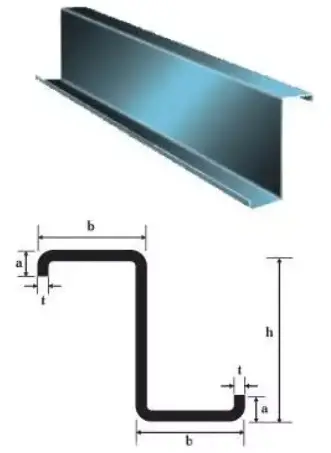
Cold-formed Z-shaped steel has the advantages of adjustable specification and size and large compressive strength.
It is widely used in automobile, railway vehicle, building doors and windows, transportation, shelf, electrical cabinet, highway guardrail, building steel structure, container, steel formwork and scaffold, solar support shipbuilding, bridge, power transmission tower, steel sheet pile, cable bridge, agricultural machinery, furniture, storage, guide rail, keel steel Vegetable greenhouses, pipe supports, municipal construction fields etc.
| No | Item | Model | Unit | Weight |
|---|---|---|---|---|
| 1 | Cold Bend Z Section Steel | Z80×40×2.5 | kg/m | 2.947 |
| 2 | Cold Bend Z Section Steel | Z80×40×3.0 | kg/m | 3.491 |
| 3 | Cold Bend Z Section Steel | Z100×50×2.5 | kg/m | 3.732 |
| 4 | Cold Bend Z Section Steel | Z100×50×3.0 | kg/m | 4.432 |
| 5 | Cold Bend Z Purlin Steel | Z100×40×20×2.0 | kg/m | 3.208 |
| 6 | Cold Bend Z Purlin Steel | Z100×40×20×2.5 | kg/m | 3.932 |
| 7 | Cold Bend Z Purlin Steel | Z120×50×20×2.0 | kg/m | 3.835 |
| 8 | Cold Bend Z Purlin Steel | Z120×50×20×2.5 | kg/m | 4.718 |
| 9 | Cold Bend Z Purlin Steel | Z120×50×20×3.0 | kg/m | 5.569 |
| 10 | Cold Bend Z Purlin Steel | Z140×50×20×2.5 | kg/m | 5.11 |
| 11 | Cold Bend Z Purlin Steel | Z140×50×20×3.0 | kg/m | 6.04 |
| 12 | Cold Bend Z Purlin Steel | Z160×60×20×2.5 | kg/m | 5.895 |
| 13 | Cold Bend Z Purlin Steel | Z160×60×20×3.0 | kg/m | 6.982 |
| 14 | Cold Bend Z Purlin Steel | Z160×70×20×2.5 | kg/m | 6.288 |
| 15 | Cold Bend Z Purlin Steel | Z160×70×20×3.0 | kg/m | 7.453 |
| 16 | Cold Bend Z Purlin Steel | Z180×70×20×2.5 | kg/m | 6.679 |
| 17 | Cold Bend Z Purlin Steel | Z180×70×20×3.0 | kg/m | 7.924 |
| 18 | Cold Bend Z Purlin Steel | Z200×70×20×2.5 | kg/m | 7.073 |
| 19 | Cold Bend Z Purlin Steel | Z200×70×20×3.0 | kg/m | 8.394 |
| 20 | Cold Bend Z Purlin Steel | Z230×75×25×3.0 | kg/m | 9.573 |
| 21 | Cold Bend Z Purlin Steel | Z230×75×25×4.0 | kg/m | 12.51 |
| 22 | Cold Bend Z Purlin Steel | Z250×75×25×3.0 | kg/m | 10.04 |
| 23 | Cold Bend Z Purlin Steel | Z250×75×25×4.0 | kg/m | 13.14 |

